Bangladeshi taka
The Bangladeshi taka (Bengali: টাকা, sign: ৳, code: BDT, short form: Tk) is the currency of the People's Republic of Bangladesh. In Unicode, it is encoded at U+09F3 ৳ (HTML ৳).
| Bangladeshi taka | |
|---|---|
| টাকা (Bengali) | |
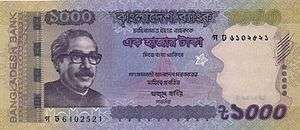 ৳1000 banknote (obverse) | |
| ISO 4217 | |
| Code | BDT |
| Denominations | |
| Subunit | |
| 1/100 | poysha (defunct) |
| Symbol | ৳ |
| poysha | p |
| Banknotes | |
| Freq. used | ৳10, ৳20, ৳50, ৳100, ৳200, ৳500 and ৳1000 |
| Rarely used | ৳2, ৳5 |
| Coins | |
| Freq. used | ৳2, ৳5 |
| Rarely used | 50 poysha, ৳1 |
| Demographics | |
| User(s) | |
| Issuance | |
| Central bank | Bangladesh Bank |
| Printer | The Security Printing Corporation Bangladesh Ltd. |
| Website | www |
| Mint | The Security Printing Corporation Bangladesh Ltd. |
| Valuation | |
| Inflation | 5.57% |
| Source | BBS, July 2017 [1] |
Issuance of banknotes ৳10 and larger is controlled by Bangladesh Bank, and for the ৳2 and ৳5 banknotes, which are the responsibility of the ministry of finance of the government of Bangladesh. The most commonly used symbol for the taka is "৳" and "Tk", used on receipts while purchasing goods and services. It was formerly divided into 100 poysha, but poysha coins are no longer in circulation
Etymology

According to The American Heritage Dictionary of the English Language and Banglapedia, the word taka came from Sanskrit word tankah.[2][3] Another hypothesis is that the word is derived from a Turkic word Tamga or tamgha (Ottoman Turkish: طمغا, Old Turkic: 𐱃𐰢𐰍𐰀, Turkish: Damga), "stamp, seal".[4] Many Turkic-speaking areas in Central Asia were once centers of Indo-Iranian languages. There was a synthesis of Turkic and Iranian cultures, which is known as the Turco-Persian tradition. The Persianized Turks conquered large parts of the Indian subcontinent, giving rise to an Indo-Persian culture. Many kingdoms that used the currency had Persian and Sanskrit as official languages.
The word taka in Bangla is also commonly used generically to mean any money, currency, or notes. Thus, colloquially, a person speaking in Bangla may use "taka" to refer to money regardless of what currency it is denominated in. This is also common in the Indian states of West Bengal and Tripura, where the official name of the Indian rupees is "taka" as well. In other eastern Indian languages with the influence of Prakrit, in Assam it is টকা tôka and it is ଟଂକା tôngka in Odisha.
History
1947–71
After the Partition of Bengal in 1947, in East Bengal, which later became the eastern wing of Pakistan union and was renamed to East Pakistan in 1956, the Pakistani rupee also bore the word taka on official notes and coins. Bangla was one of the two national languages of the Pakistan union between 1956 and 1971 (the other being Urdu in West Pakistan). The Bangladeshi taka came into existence since 1972, a year after the independence of the eastern wing of the union, as the independent nation of Bangladesh.
Prior to the Liberation war in 1971, banknotes of the State Bank of Pakistan circulated throughout Bangladesh, and continued to be used in Bangladesh even after independence for only about three months until the official introduction of the taka on 4 March 1972. During the war, it was an unofficial practice of some Bengali nationalists to protest Pakistani rule by stamping banknotes with "বাংলা দেশ" and "BANGLA DESH" as two words in either Bangla or English. These locally produced stamps are known to exist in several varieties, as are forgeries. On 8 June 1971, the Pakistani government declared that all banknotes bearing such stamps ceased to be legal tender. Furthermore, to prevent looted high-denomination notes from disrupting the Pakistani economy, the government also withdrew the legal tender status of all 100- and 500-rupee notes.[5]
Some foreign publications mention that there were rubber stamp "BANGLA DESH" overprints on different denominations of Pakistani bank notes during the a.m. period. It may be mentioned that Pakistani postage stamps were rubber-stamped and used all over Bangladesh until 30 March 1973, but Bangladesh Bank or the Ministry of Finance never issued an order to overprint or rubber-stamp Pakistani currency.[6] It would be interesting to note here, that a counterfeiting gang is active, which uses a "washing system", whereby ৳100 notes are washed with a special kind of liquid, and the numbers are changed to give it the appearance of a ৳500 note.[7]
Since 1972
Treasury banknotes
- The first treasury notes in 1972 for ৳1 and notes of the Bangladesh Bank for ৳5, ৳10 and ৳100.
- In 1977, banknotes for ৳50 were introduced, followed by ৳500 in 1979 and ৳20 in 1982.
- ৳1 treasury notes were issued until 1992, with ৳2 treasury notes introduced in 1989.
- ৳1000 banknotes were introduced in 2008.
- ৳5 banknotes, previously issued by Bangladesh Bank, are now issued by the Government of Bangladesh.
Banknotes and issues
In 2000, the government issued polymer ৳10 notes as an experiment (similar to the Australian dollar). They proved unpopular, however, and were withdrawn later. At present, the ৳1 and ৳5 notes are gradually being replaced with coins, and in 2008, the government issued ৳1,000 notes.
In 2011, Bangladesh Bank began issuing a new series of banknotes denominated in ৳2, ৳5, ৳100, ৳500, and ৳1000. All are dated 2011 and feature a portrait and watermark of the Father of the Nation, Bangabandhu Sheikh Mujibur Rahman, along the National Martyr's Monument in Savar at center front.[8]
From 2011, the Bangladesh Bank introduced new notes denominated in ৳10, ৳20, and ৳50 on 7 March 2012. The notes bear the portrait of Bangabandhu Sheikh Mujibur Rahman and the National Martyr's Monument in Savar on the front. On the back of the notes, the ৳10 will picture the Baitul Mukarram mosque, the ৳20 pictures the Shat Gombuj mosque in Bagherat, and the ৳50 notes feature Shilpacharjo Zainul Abedin's famous painting "Ploughing."[9]
On March 7 of 2019, Bangladesh Bank released new ৳100 notes,which had the same design as 2011 Version, but had better security, a stronger Blue and was made of a different material.
On December 15 of 2019,Bangladesh Bank issued new ৳50 banknotes, with the same design as the 2011 version,but had a different colour (Orange,Brown and Fluorescent Yellow-Green) and has a slightly different design in some parts.
On March 17 of 2020,Bangladesh Bank introduced new ৳200 notes. They bear a portrait of Bangabandhu Sheikh Mujibur Rahman on both sides and a landscape picture of a village and a River and Boats.
Commemorative banknotes
In 2011, Bangladesh Bank also introduced a ৳40 note to commemorate the "40th Victory Anniversary of Bangladesh". The commemorative note features a portrait of the Father of the Nation, Bangabandhu Sheikh Mujibur Rahman and the National Martyr's Monument in Savar on front, and six armed men on back. Curiously, this note has an electrotype 10 in the watermark, indicating it was likely printed on extra ৳10 banknote paper.[10]
On 15 February 2012, Bangladesh Bank has introduced a ৳60 note to commemorate "60 years of National Movement". The commemorative note measures 130 by 60 millimetres (5.1 in × 2.4 in) and features the Shaeed Minar (Martyrs' monument) in Dhaka and five men on the back. Like the ৳40 commemorative note, this note has an electrotype 50 in the watermark. It was likely printed on extra ৳50 banknote paper.[11]
On 26 January 2013, Bangladesh Bank issued a ৳25 note to commemorate the 25th anniversary (silver jubilee) of the Security Printing Corporation (Bangladesh) Ltd. On the front is the National Martyr's Monument in Savar, the designs of the previous series of the Bangladeshi taka notes and its postage stamps, three spotted deer and the magpie robin (doyel) bird. On the reverse is the headquarters of the Security Printing Corporation. Curiously, this note has an electrotype 10 in the watermark, indicating it was likely printed on extra ৳10 banknote paper.[12]
On 8 July 2013, Bangladesh Bank issued a ৳100 note to commemorate the 100th anniversary of the Bangladesh National Museum. The commemorative note features an 18th-century terracotta plaque of a horseman on the front and the Bangladesh National Museum on the back.[13]
Coins
In 1973, coins were introduced in denominations of 5, 10, 25 and 50 poysha. 1 poysha coins followed in 1974, with ৳1 coins introduced in 1975. The 1, 5 and 10 poysha were struck in aluminium, with the 25 and 50 poysha struck in steel and the ৳1 in copper-nickel. The 5 poysha were square with rounded corners, and the 10 poysha were scalloped. Steel ৳5 were introduced in 1994, and a steel ৳2 coin followed in 2004.
1 and 5 poysha coins are rarely found in circulation. 10, 25, and 50 poysha coins do not circulate widely. Only the ৳1, ৳2 and ৳5 are regularly found in circulation.
| 1973 Series | ||||
|---|---|---|---|---|
| Value | Composition | Description | first mint | |
| Reverse | Obverse | |||
| 5 poysha | Aluminium | National emblem | 1973 | |
| 10 poysha | ||||
| 25 poysha | Steel | Rohu | ||
| 50 poysha | ||||
| 1974 Series (FAO) | ||||
| 1 poysha | Aluminium | National emblem | Ornamental design, floral patterns | 1974 |
| 5 poysha | ||||
| 10 poysha | ||||
| 25 poysha | Steel | |||
| ৳ | Various | Four human figures, slogan "Planned family – Food for All" | 1975 | |
| 1977 Series (FAO) | ||||
| 5 poysha | Aluminium | National emblem | Plough, Industrial wheel | 1977 |
| 10 poysha | A man and a woman seated on 2 back steeds facing each other | |||
| 25 poysha | Steel | Royal Bengal tiger | ||
| 50 poysha | Hilsha fish, chicken, pineapple, banana | |||
| Newer Issues | ||||
| 50 poysha | Steel | National emblem | Hilsha fish, chicken, pineapple, banana | 2001 |
| ৳1 | Four human figures, slogan "Planned family – Food for All" | 1992 | ||
| ৳1 | Four human figures, slogan "Planned family – Food for All" (Golden Version) |
1996 | ||
| ৳1 | Four human figures, slogan "Planned family – Food for All" | 2003 | ||
| ৳1 | Sheikh Mujibur Rahman | 2010 | ||
| ৳2 | Steel | National emblem | Education for All | 2004 |
| ৳2 | Sheikh Mujibur Rahman | 2010 | ||
| ৳5 | Jamuna Multipurpose Bridge | 1994 | ||
| ৳5 | Steel | Sheikh Mujibur Rahman | Bangladesh Bank logo | 2012 |
Banknotes
Rarely used banknotes of the Bangladeshi taka are ৳1 (withdrawn as well since 1992), ৳25, ৳40 and ৳60, ৳70 and the most frequently used banknotes in circulation are ৳2, ৳5, ৳10, ৳20, ৳50, ৳100, ৳500 and ৳1000.
Bangladesh Bank has withdrawn the new ৳50 note after a spelling mistake of Shilpacharjo Zainul Abedin (জয়নুল আবেদীন) which was identified on the back of the note. The note had just been introduced on 7 March, so it is likely that very few made it into circulation, even though 22.5 million pieces were printed.[14]
| Banknotes before the 2011 Series | |||||||||||
|---|---|---|---|---|---|---|---|---|---|---|---|
| Image | Value | Dimensions | Main colours | Description | Date of | Remarks | |||||
| Obverse | Reverse | Obverse | Reverse | issue | Status | ||||||
| ৳2 | 100 × 60 mm | Orange and green | Shaheed Minar | National bird, the doyel | 29 December 1988 | No longer in circulation | Replaced by 2 taka coins. | ||||
| ৳5 | 119 × 64 mm | Cream | Kusumba Mosque | Industrial landscape | 8 October 2006 | No longer in circulation | First issued on 2 May 1978 | ||||
| ৳10 | 122 × 59 mm | Pink | Baitul Mukarram | Jatiyo Sangshad Bhaban | Present version 21 September 2006 | No longer in circulation | First issued on 2 June 1972 | ||||
| ৳20 | 130 × 60 mm | Green | Choto Sona Mosque | 4 men washing jute | Present version 13 July 2002 | No longer in circulation | First issued on 20 August 1979 | ||||
| ৳50 | 130 × 60 mm | Cream, lime green | Jatiyo Sangshad Bhaban | Bagha Mosque | Present version 30 July 2005 | No longer in circulation | First issued on 1 March 1976 | ||||
| ৳100 | 140 × 62 mm | Blue | National Monument | Jamuna Bridge | Present version 16 July 2006 | No longer in circulation | First issued on 1 September 1972 | ||||
| ৳500 | 153 × 69 mm | Purple | National Monument | The Supreme Court, Dhaka | Present version 24 October 2004 | No longer in circulation | First issued on 15 December 1976 | ||||
| ৳1000 | 160 x 72 mm | Reddish pink | Shaheed Minar | Curzon Hall | Present version 27 October 2008 | No longer in circulation | First issued on 27 October 2008 | ||||
 |
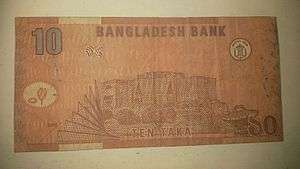 |
৳10 taka polymer note | 152 x 64 mm | Pink | Bangabandhu | Jatiyo Sangshad Bhaban | 14 December 2000 | Withdrawn | First and only polymer note in Bangladesh | ||
The Bangladesh Bank has issued a new series of banknotes, phasing out the older designs for new, more secure ones. All banknotes other than the 1 taka feature a portrait of Sheikh Mujibur Rahman on the obverse along with the watermark of the National Martyrs’ Memorial.[15]
| Bangabandhu Series (2011)[16] | |||||||
|---|---|---|---|---|---|---|---|
| Image | Value | Dimensions | Main Colour | Description | Period | ||
| Obverse | Reverse | Obverse | Reverse | ||||
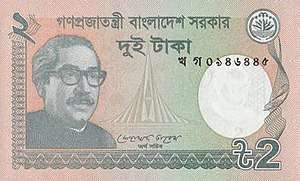 |
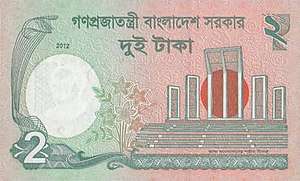 |
৳2 | 100 × 65 mm | Green and Salmon Pink | Bangabandhu Sheikh Mujibur Rahman |
Shaheed Minar, Dhaka | 9 August 2011 – present |
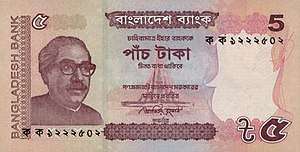 |
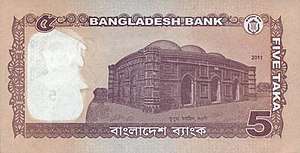 |
৳5 | 110 × 65 mm | Grey and Salmon Pink | Kusumba Mosque | 9 August 2011 – present | |
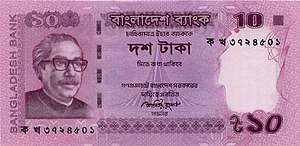 |
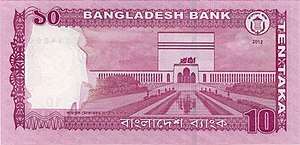 |
৳10 | 115 × 65 mm | Pink | Baitul Mukarram | 7 March 2012 – present | |
 |
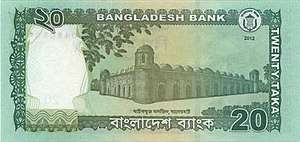 |
৳20 | 120 × 65 mm | Yellow and Green | Sixty Dome Mosque | 7 March 2012 – present | |
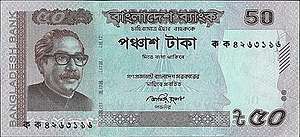 |
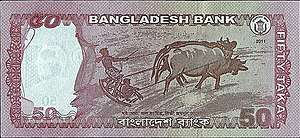 |
৳50 | 131 × 65 mm | Red and Brown | Zainul Abedin's painting "Ploughing" | 7 March 2012 – present | |
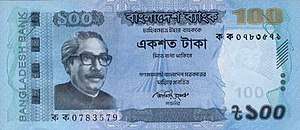 |
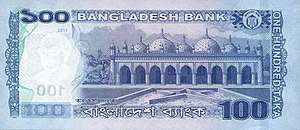 |
৳100 | 139 × 65 mm | Blue | Star Mosque | 9 August 2011 – present | |
| ৳200 | 139 × 65 mm | Yellow and red | Sheikh Mujibur Rahman, Agriculture in Bangladesh | 17 March 2020 – present | |||
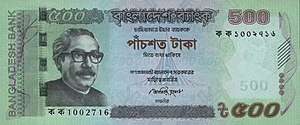 |
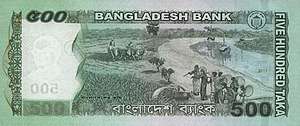 |
৳500 | 147 × 65 mm | Rich Deep Green and Blue | Agriculture in Bangladesh | 9 August 2011 – present | |
 |
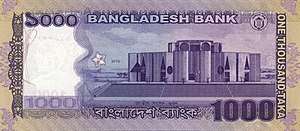 |
৳1000 | 155 × 65 mm | Purple and Brown | Jatiya Sangsad Bhaban | 9 August 2011 – present | |
The folder of the banknote for the 40th anniversary of the independence of Bangladesh had a spelling error of the name of the country. It was inserted as Bangldesh instead of Bangladesh.[18]
| Commemorative banknotes of the Bangladeshi taka | |||||||||||
|---|---|---|---|---|---|---|---|---|---|---|---|
| Obverse | Reverse | Folder | Value | Dimensions | Main colours | Description | Year of issue | Date of first issue | Print volume | Watermark | |
| Obverse | Reverse | ||||||||||
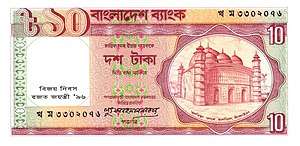 |
 |
no folder | ৳10 | Violet on multicolor underprint | Atiya Jam-e Mosque in Tangali | Spillway of Kaptai Dam | 1996 | Modified tiger head; overprint on obverse watermark area: "VICTORY DAY SILVER JUBILEE'96" | |||
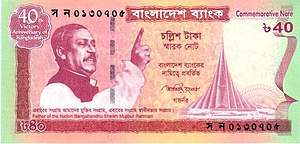 |
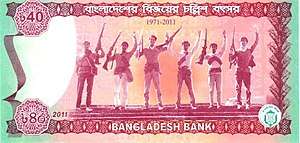 |
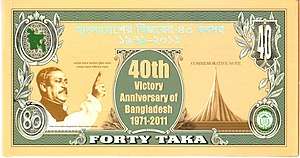 |
৳40 | 122 x 60 mm | Dark red, orange, and green | Bangabandhu; National monument (Savar) | Soldiers | 2011 | 21 December 2011 | Sheikh Mujibur Rahman, electrotype 10 denomination and bank logo | |
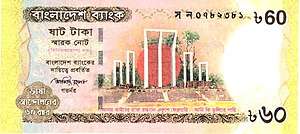 |
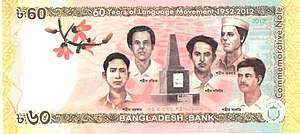 |
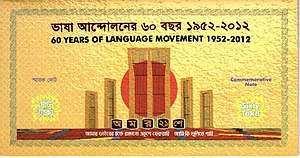 |
৳60 | 130 x 60 mm | Yellow, brown, violet, orange, and blue | Shaheed Minar monument | Veterans of the "Language Movement", first Shaheed Minar monument (1952) | 2012 | 15 February 2012 | 20,000
(5000 in folders) |
Sheikh Mujibur Rahman on pixelated background, electrotype bank logo and 50 |
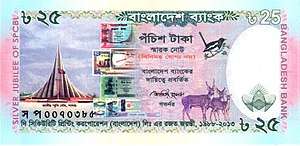 |
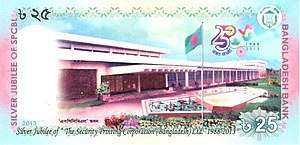 |
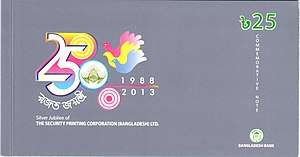 |
৳25 | 123 x 60 mm | Blue, purple and red | National Martyr's Monument in Savar, Bangladeshi taka banknotes and postage stamps, three spotted deer, magpie robin (doyel) bird | Headquarters of the Security Printing Corporation | 2013 | 26 January 2013 | Sheikh Mujibur Rahman, electrotype 10 denomination and bank logo | |
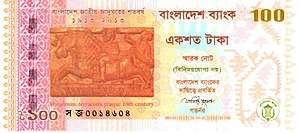 |
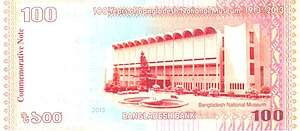 |
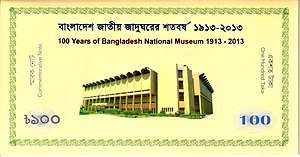 |
৳100 | 140 x 62 mm | Blue and red | 18th-century terra-cotta plaque of a horseman | Bangladesh National Museum | 2013 | 9 July 2013 | 100,000
(11,000 in folders) |
Sheikh Mujibur Rahman on a pixelated background, electrotype 100 denomination and bank logo |
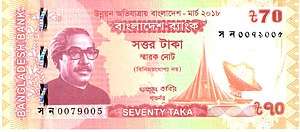 |
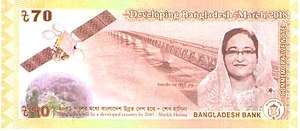 |
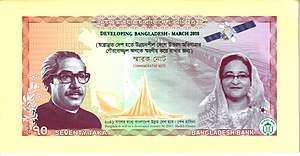 |
৳70 | 140 x 62 mm | Purple, orange and green | Sheikh Mujibur Rahman; map of Bangladesh; National Martyrs’ Monument in Savar; Betbunia Satellite Center | Bangabandhu-1 Satellite in orbit above earth; Padma Bridge; Prime Minister Sheikh Hasina; bank logo | 2018 | 22 March 2018 | Sheikh Mujibur Rahman on a pixelated background, electrotype 100 denomination and bank logo | |
Exchange rates
Historic exchange rates
Upon Bangladesh's independence, the value of the Bangladeshi taka was set between ৳7.5 and ৳8.0 to US$1. Except for fiscal year 1978, the taka's value relative to the US dollar declined every year from 1971 through the end of 1987. To help offset this phenomenon, Bangladesh first used the compensatory financing facility of the International Monetary Fund in fiscal year 1974. Despite the increasing need for assistance, the Mujib government was initially unwilling to meet the IMF's conditions on monetary and fiscal policy. By fiscal year 1975, however, the government revised its stance, declaring a devaluation of the taka by 56 percent and agreeing to establishing the Bangladesh Aid Group by the World Bank.[19]
Between 1980 and 1983, the taka sustained a decline of some 50 percent because of a deterioration in Bangladesh's balance of payments.[19] Between 1985 and 1987, the taka was adjusted in frequent incremental steps, stabilising again around 12 percent lower in real terms against the US dollar, but at the same time narrowing the difference between the official rate and the preferential secondary rate from 15 percent to 7.5 percent.[19] Accompanying this structural adjustment was an expansion in trade conducted at the secondary rate, to 53 percent of total exports and 28 percent of total imports.[19] In mid-1987, the official rate was relatively stable, approaching less than ৳31 to US$1.[19] In January 2011, US$1 was equivalent to approximately ৳72,[20] as of 21 April 2012, US$1 was worth close to ৳82, and as of 9 September 2015 US$1 valued ৳77.
| Currency | ISO code | 1971 | 1981 | 1991 | 1996 | 2000 | 2001 | 2005 | 2007 | 2008 | 2009 | 2010 | 2011 | 2012 | 2013 | 2014 | 2015 |
|---|---|---|---|---|---|---|---|---|---|---|---|---|---|---|---|---|---|
| U.S. dollar | USD | 7.86 | 18.31 | 36.75 | 40.8 | 50.82 | 53.84 | 58.11 | 67.29 | 67.34 | 67.40 | 68.11 | 69.84 | 81.64 | 78.31 | 76.45 | 78.85 |
| Japanese yen | JPY | 0.02 | 0.09 | 0.27 | 0.38 | 0.48 | 0.46 | 0.56 | 0.55 | 0.62 | 0.74 | 0.74 | 0.84 | 1.06 | 0.88 | 0.73 | 0.64 |
| Soviet ruble (till 1993) Russian ruble (1993 – present) | SUR RUB | 14.93 | 29.00 | 55.12 | 8.16 | 1.85 | 1.91 | 2.17 | 2.62 | 2.79 | 2.14 | 2.31 | 2.35 | 2.66 | 2.63 | 2.29 | 1.20 |
| Euro | EUR | – | – | – | – | 51.48 | 50.57 | 76.37 | 87.45 | 98.99 | 90.01 | 97.28 | 93.26 | 105.26 | 103.98 | 104.22 | 89.26 |
| Pound sterling | GBP | 18.92 | 44.02 | 71.01 | 62.48 | 83.23 | 79.59 | 109.35 | 131.74 | 132.6 | 97.66 | 110.01 | 110.04 | 126.57 | 125.19 | 125.90 | 116.13 |
| Swiss franc | CHF | 1.8 | 10.08 | 28.89 | 34.63 | 31.97 | 33.07 | 49.38 | 53.73 | 60.99 | 60.23 | 65.87 | 73.1 | 86.91 | 84.7 | 84.66 | 81.26 |
| Hong Kong dollar | HKD | 1.31 | 3.53 | 4.68 | 5.28 | 6.53 | 6.9 | 7.45 | 8.62 | 8.62 | 8.69 | 8.77 | 8.97 | 10.51 | 10.1 | 9.85 | 9.86 |
| Malaysian ringgit | MYR | 2.55 | 8.23 | 13.54 | 15.97 | 13.37 | 14.16 | 15.25 | 19.12 | 20.54 | 18.86 | 20.06 | 22.71 | 26.14 | 25.68 | 23.14 | 21.41 |
| Kuwaiti dinar | KWD | 22.09 | 64.51 | 128.73 | 136.25 | 167.01 | 176.05 | 197.82 | 231.69 | 245.83 | 235.31 | 236.52 | 247.62 | 292.46 | 277.6 | 270.16 | 259.66 |
| Saudi riyal | SAR | 1.75 | 5.5 | 9.79 | 10.88 | 13.55 | 14.35 | 15.49 | 17.93 | 17.92 | 17.95 | 18.14 | 18.6 | 21.76 | 20.87 | 20.38 | 20.36 |
| Emirate dirham | AED | 1.65 | 4.89 | 9.96 | 11.11 | 13.84 | 14.65 | 15.82 | 18.31 | 18.33 | 18.34 | 18.54 | 19.01 | 22.22 | 21.31 | 20.81 | 20.82 |
| Indian rupee | INR | 1.00 | 2.3 | 2.00 | 1.14 | 1.16 | 1.15 | 1.32 | 1.51 | 1.71 | 1.35 | 1.47 | 1.51 | 1.56 | 1.44 | 1.23 | 1.22 |
Current exchange rates
| Current BDT exchange rates | |
|---|---|
| From Google Finance: | AUD CAD CHF EUR GBP HKD JPY USD INR RUB CNY |
| From Yahoo! Finance: | AUD CAD CHF EUR GBP HKD JPY USD INR RUB CNY |
| From XE.com: | AUD CAD CHF EUR GBP HKD JPY USD INR RUB CNY |
| From OANDA: | AUD CAD CHF EUR GBP HKD JPY USD INR RUB CNY |
| From fxtop.com: | AUD CAD CHF EUR GBP HKD JPY USD INR RUB CNY |
See also
- Economy of Bangladesh
- The Security Printing Corporation (Bangladesh) Ltd.
References
- https://www.bb.org.bd/econdata/inflation.php
- https://www.ahdictionary.com/word/search.html?q=taka
- http://en.banglapedia.org/index.php?title=Taka
- https://www.theibns.org/joomla/index.php?option=com_content&view=article&id=5&Itemid=28
- Linzmayer, Owen (2012). "Bangladesh". The Banknote Book. San Francisco, CA.
- "BANGLADESH". www.banknote.ws.
- Sakhawat, Adil (23 May 2014). "Taka fakers". Dhaka Tribune.
- "Bangladesh new note family confirmed". banknotenews.com.
- "Bangladesh new 10-, 20-, and 50-taka notes confirmed". banknotenews.com.
- "Bangladesh new 40-taka commemorative confirmed". banknotenews.com.
- "Bangladesh new 60-taka commemorative note confirmed". banknotenews.com.
- "Bangladesh new 25-taka commemorative note confirmed". banknotenews.com.
- "Bangladesh new 100-taka commemorative note confirmed". banknotenews.com.
- "Bangladesh new 50-taka note withdrawn due to error". banknotenews.com.
- https://www.bb.org.bd/currency/note.php
- "Bangladeshi Banknotes". Bangladesh Bank. 17 January 2017. Retrieved 17 January 2017.
- "Bangladesh banknotes - Bangladesh paper money catalog and Bangladeshi currency history". www.atsnotes.com.
- https://banknoteindex.com/browse.mhtml?browseBy=Id&browse=55629
- Lesser, Lawrence B. (1989). "Money and Banking". In Heitzman, James; Worden, Robert (eds.). Bangladesh: A Country Study. Washington, D.C.: Federal Research Division, Library of Congress. pp. 108–109.
- "Historical Exchange Rates". OANDA. OANDA Corporation. Archived from the original on 2 February 2011. Retrieved 3 January 2011.
- Krause, Chester L.; Clifford Mishler (1991). Standard Catalog of World Coins: 1801–1991 (18th ed.). Krause Publications. ISBN 0873411501.
- Pick, Albert (1994). Standard Catalog of World Paper Money: General Issues. Colin R. Bruce II and Neil Shafer (editors) (7th ed.). Krause Publications. ISBN 0-87341-207-9.
External links
- Bangladesh Bank's page on currencies in circulation
- High resolution scans of Bangladeshi currency
- Historical banknotes of Bangladesh